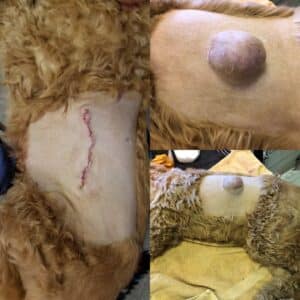Article Summary
- It is common for dogs to develop lumps, and a veterinarian can help diagnose if they need to be surgically removed.
- Some masses can’t be diagnosed properly until they are removed, so surgery may be necessary for dogs that develop lumps.
- Cysts and tumors are different types of lumps that dogs can develop and some may need to be surgically removed.
Your Dog Has a Lump? Here Are The Steps You Need To Take
Any lump or bump on a dog has the potential to make a dog owner think the worst. After all, it can be alarming to find an unexpected bump during a bath or in the middle of a snuggle. But, before jumping to conclusions, pet owners should take a deep breath and understand that bumps and lumps are pretty common for dogs.
They generally fall into two categories: cysts or tumors. And even those categories can be split again to include malignant (or cancerous) tumors or benign (noncancerous) tumors. Of course, the best course of action for dog owners who find a lump is to have it checked by a veterinarian.
And if surgery is recommended, the surgical professionals at Dr. Kelly’s Surgical Unit are always ready to help.

Skin Lumps In Dogs
Cysts and tumors both present as lumps, if they’re on the surface. Generally speaking, a cyst is a space within a tissue that fills with either liquid or solid materials. It could be body oil, secretions or dead cells, and there is a wide variety when it comes to the types of cysts that dogs can develop. Here’s a brief rundown.
- Sebaceous: Associated with hair follicles and develop around sebaceous glands.
- Follicular: Dilated hair follicles that contain fluid or dark-colored material.
- Dermoid: These are rare, congenital cysts that develop before birth.
- True cysts: Often form in sweat glands as a result of blocked ducts.
Depending on the type, cysts can take on different appearances. Some may appear as nodules, others as raised bumps. Some look like hard tissue masses under the skin and some, if they rupture, may ooze substances that range in color from white to brown to a cottage-cheese-like discharge.
To know for sure, however, if a lump is a cyst or a tumor, a veterinary consultation is necessary. During that examination, a vet can either biopsy or utilize a fine needle aspiration to properly identify the type of lump a dog is dealing with.

Tumor Vs. Cyst
Common tumors in dogs can also vary by type, just like cysts. What’s tricky, and at-times unnerving, is that malignant and benign tumors can have similar appearances. And some tumors can’t be designated as cancerous or benign until after they are removed.
There are a number of types of cancerous tumors that dogs can develop, but here is a brief list. A more expansive list if available on PetMD.
- Fibrosarcoma: A rare, malignant tumor that forms in connective tissue.
- Mast Cell Tumor: Malignant tumors that form in a dog’s skin.
- Squamous Cell Carcinoma: A type of skin cancer in dogs.
- Basal Cell Carcinoma: A type of skin cancer in dogs.
Affordable Dog Surgery
Once a lump is diagnosed by a veterinarian, and if surgery is determined to be needed, dog owners in need of cyst or tumor removal surgery can count on the affordable care offered by Dr. Kelly’s Surgical Unit.
While the cost of surgery to remove cysts and cancerous masses can vary based on the size and location of the mass — among other factors, including the dog’s overall health — we at Dr. Kelly’s have made it our mission to provide affordable surgery without ever sacrificing quality of care.

Pet owners should know, though, that there may be additional costs that come along with cyst or tumor removal, including biopsy or diagnostic costs with your veterinarian, or follow-up care if it is needed. At Dr. Kelly’s Surgical Unit, we focus specifically on the surgical intervention your dog needs, and allow your veterinarian to handle the diagnostic aspect of care.
It’s one way we keep costs down for pet owners.
If your dog needs a mass removed, reach out to our surgical team at Dr. Kelly’s Surgical Unit to schedule an appointment so we can help get your dog on the road to recovery.
Dr. Kelly’s Surgical Unit is a trusted veterinary team serving the Phoenix, Peoria, East Mesa, Queen Creek, and Tucson metro areas, with accessible locations in each market, offering highly specialized surgery, quality spay and neuter procedures, and accessible dental care for pets. Contact us to learn more about our specialized services or to schedule an appointment.
